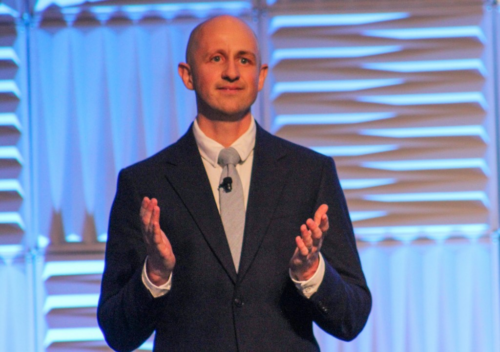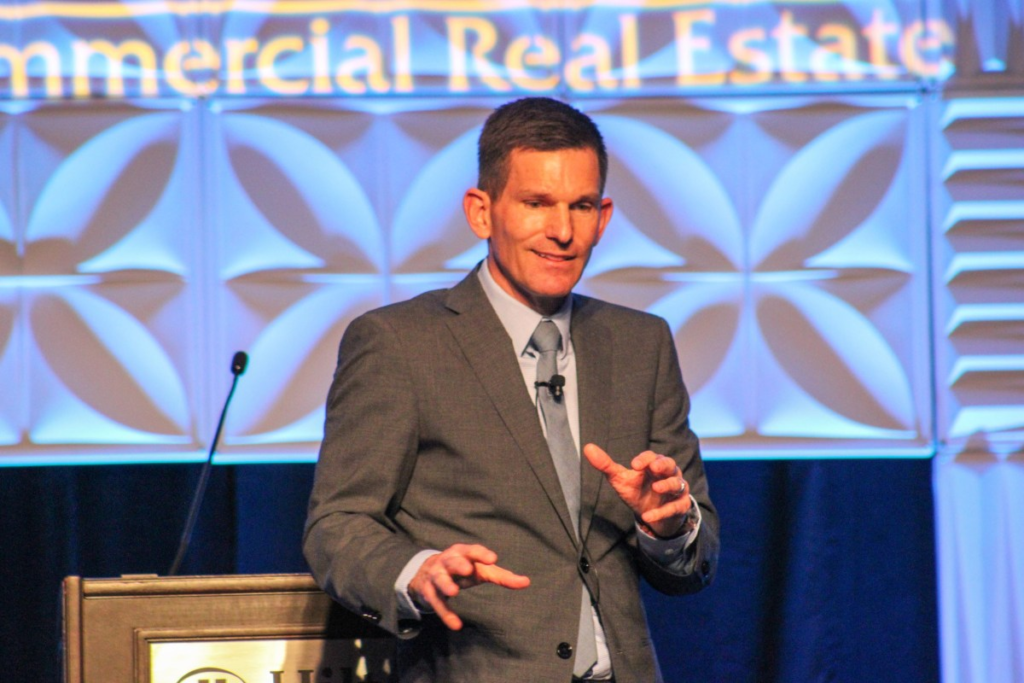
Santa Barbara, California – Published 3/15/2025
We live in the nicest place in the world.
But there’s one way to make it nicer: Build housing.
That was the advice of Christopher Thornberg, an economist and founder of Beacon Economics.
“It’s not complicated,” Thornberg said. “You want to fix State Street? Housing. You want to have more restaurants? Housing. You got to build housing.”
Thornberg, who is based out of Los Angeles, spoke to several hundred people at Wednesday’s 15th Annual Real Estate & Economic Forecast at the Hilton Santa Barbara on Cabrillo Boulevard. The crowd was full of business leaders, government officials, commercial real estate brokers, investors and other professionals.
The economist said building is such an obvious answer to stimulating the local economy.
“Why can’t they get anything done about it?” he said. “What is the problem?”
Thornberg, pacing on stage inside the Hilton’s main ballroom, said, “clearly, something has to change.”
He was one of five speakers the event. Gene Deering talked about commercial real estate and leasing, Justin Diem spoke about downtown Santa Barbara, Michael Lopus talked about apartments and multifamily investments, and Brad Frohling served as the master of ceremonies.
Diem fired up the crowd with his talk on downtown, infusing humor into his speech.
He immediately offered a disclaimer:
“I know discussing topics on the conditions of downtown may trigger some emotions, some strong opinions, and even cause some fatigue,” Diem said. “So I have decided to tone it down a hair today. I have removed a few key terms from my speech, such as parklet and E-bike, just to keep everyone in their seats.”
The crowd laughed.
Diem then offered a blunt statement.
“Here we are,” he said. “Quite the predicament. We are sitting on the razor’s edge of a crumbling downtown economy, while becoming one of the greatest cities in the world. So how can we find some clarity?”
Diem outlined State Street’s challenges: High retail vacancy rates, increased exposure in the large office market, high interest rates, high construction costs, high real estate prices, a housing crisis and a divided political landscape and, “worst of all, a closed State Street.”
Diem then called on the mayor and Santa Barbara City Council to do one thing:
“It is time to open up our street,” Diem said to loud cheers from the crowd.

The highlight of the event was Deering, whose charismatic delivery enraptured the crowd. He talked about retail and office leasing successes in Goleta, Carpinteria and Montecito.
“The Montecito market remains incredibly hot,” Deering said.
He said retailers are paying between $8 and $12 a square foot for space, double and triple what they would have rented for six years ago.
“These are rents we have never seen in our market,” Deering said. “It’s the demand for retailers who want a flagpole in Montecito. If they can get signage and windows on Coast Village, they are going to be really excited to fight over that space.”
Blackstone Real Estate in 2024 purchased Retail Opportunity Investments Corporation for $4 billion, an all-cash purchase. The acquisition included 93 shopping centers, two of them on the South Coast.
The Casitas Shopping Center in Carpinteria and Magnolia Shopping Center near Goleta were part of the deals.
“It does highlight the strength of neighborhood retail,” Deering said. “It is incredibly strong across our market.”
He said with neighborhood retail centers “you can actually park and get in easily.”
Casitas sold for $36 million. The Magnolia Shopping Center sold for $65 million.
Deering also said the Bed Bath & Beyond building in Goleta, which has been vacant for a year, may have one or two new tenants soon.
Broker Michael Lopus talked about apartment investing and new housing development.
Lopus said that a lot of Santa Barbara’s apartment buildings were built in the 1950s through 1970s so they are in need of new electric and plumbing. The old systems make insurance costs higher, Lopus said.
He said in 2025 landlords are going to have to deal with rising insurance costs and the possibility of rent control, which could cause them to sell their buildings.
“Mom and pop ownership we are starting to see fade away,” he said. “These mom and pop ownerships are starting to get hit with these large premiums. They are getting hit with additional regulations for tenants, so it is a very difficult environment.”
He said corporations with large resources are trying to build scattered site portfolios and are coming in trying to pick these properties up.
“How the city is handling these situations is really difficult on mom and pops and unfortunately starting to push them out,” Lopus said.

On the national level, economist Thornberg said one of the country’s biggest challenges going forward will be a labor shortage. He said that both Canada and Mexico have had twice the labor force growth of the United States over the past decade.
In addition to President Donald Trump’s immigration actions, Thornberg said many workers are leaving the country on their own or choosing not to come to the U.S. because of the tenor of the nation.
Thornberg also said Trump’s 25% tariffs on goods from Mexico will hurt the automobile industry.
“If he really does go through with the tariffs on Mexico, you might want to buy your car now,” Thornberg said. “Cars are integrated across North America, and not only are they increasing the tariff but they are getting rid of the tariff rebate.”
Thornberg said “it is going to play hell on the automobile industry.”
The tariffs are also going to hurt construction, he said.
“If you need anything made out of metal for your building construction, it is going to get really expensive, really quick,” Thornberg said. “There are going to be hits to the economy.”

